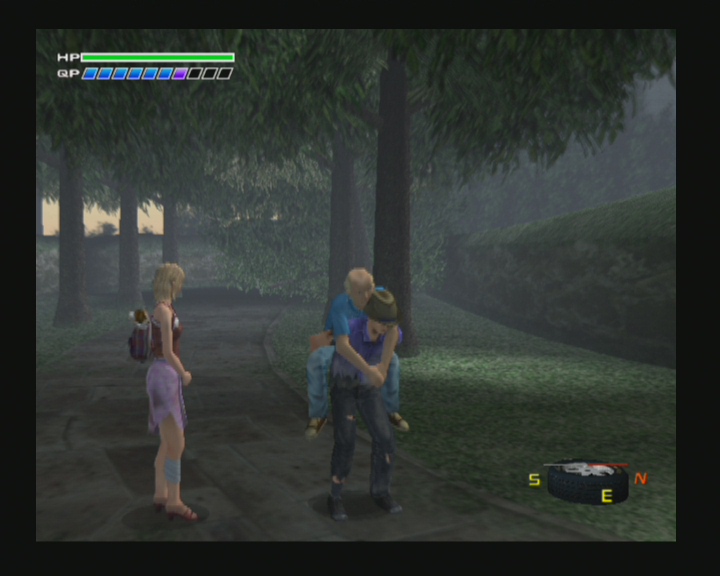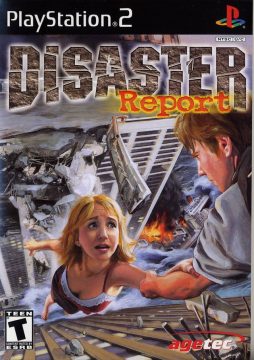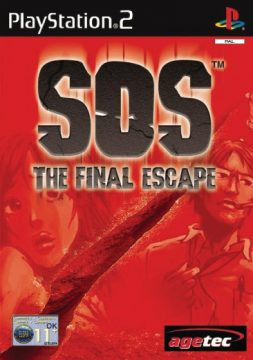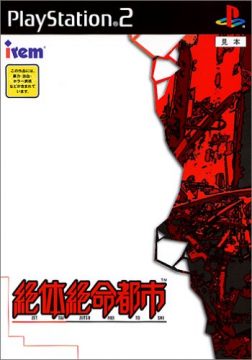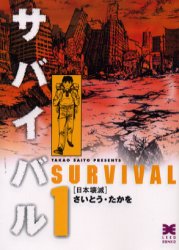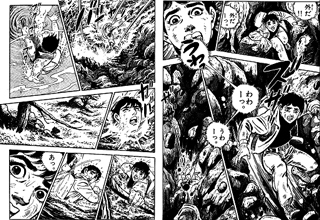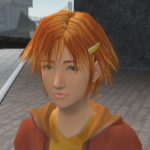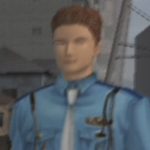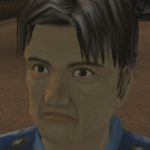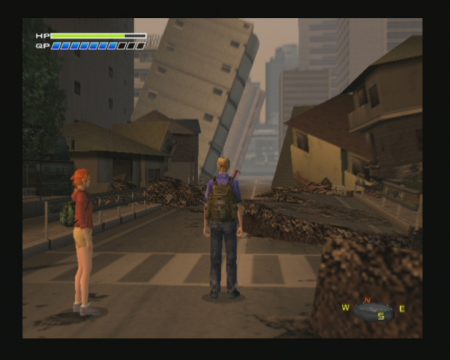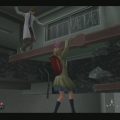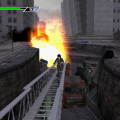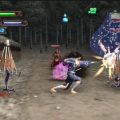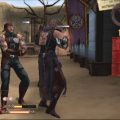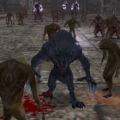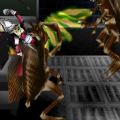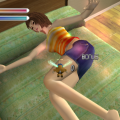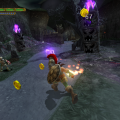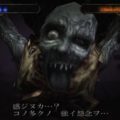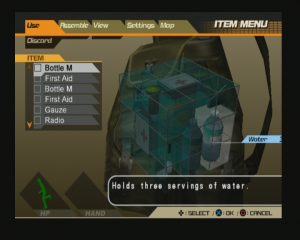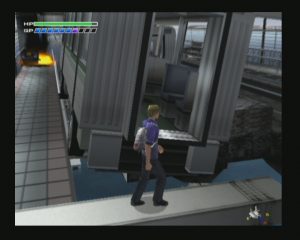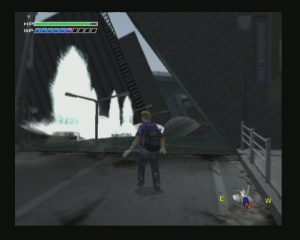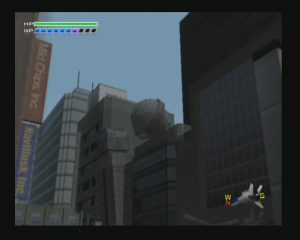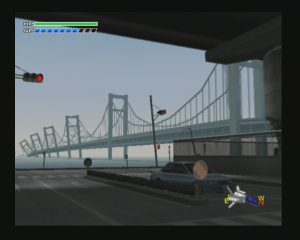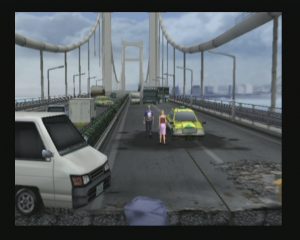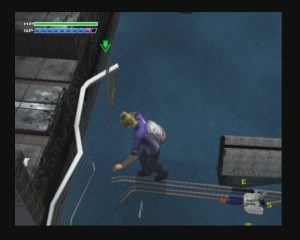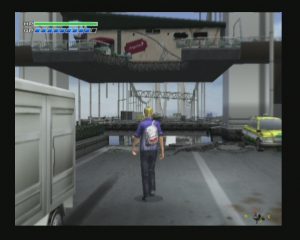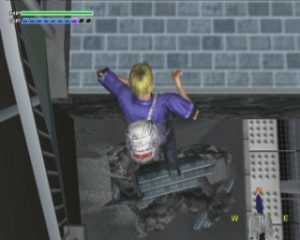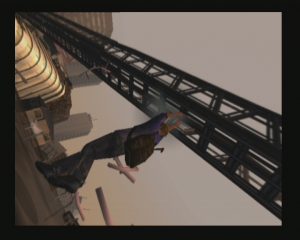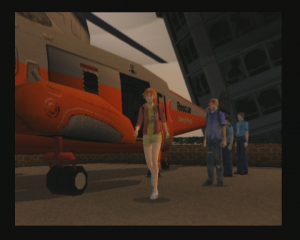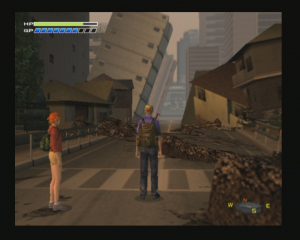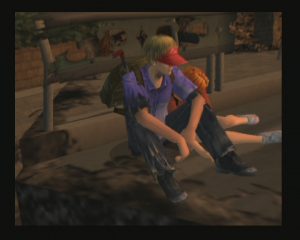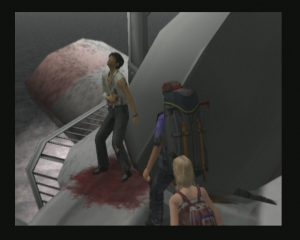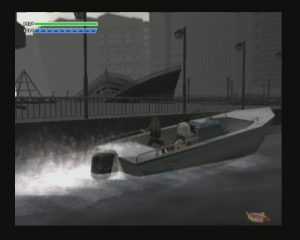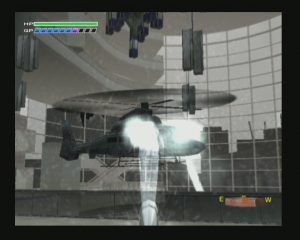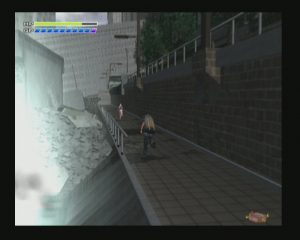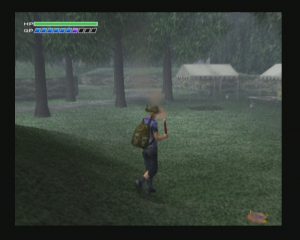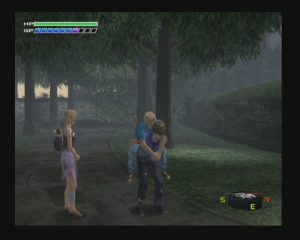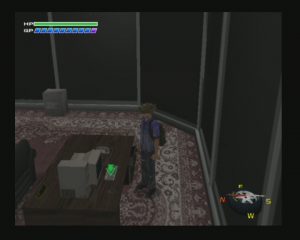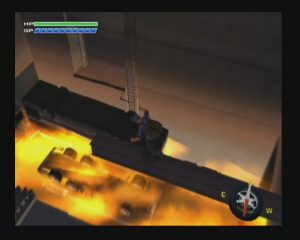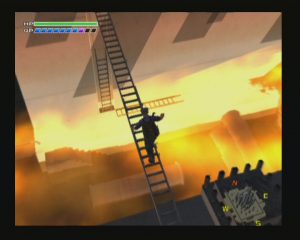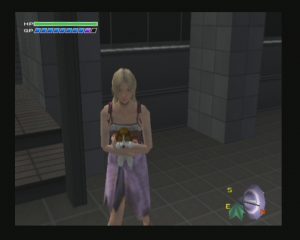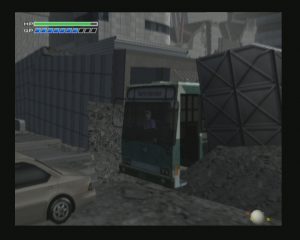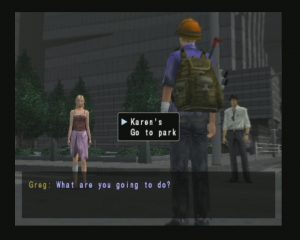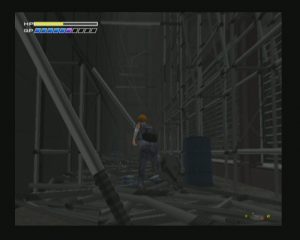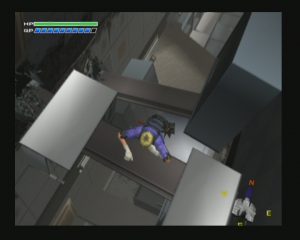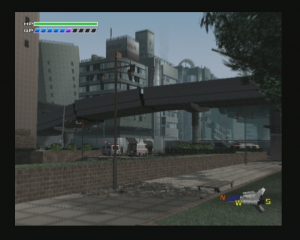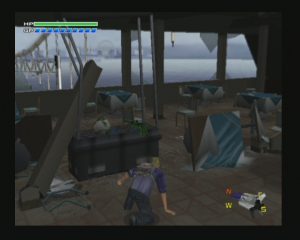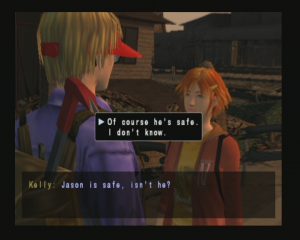For all the criticism the press raises about games not offering genuine choice, Kazuma Kujo, formerly of Irem now at Granzella, stands as an overlooked champion and creative genius. The Zettai Zetsumei Toshi series (and also his Steambot Chronicles) features a cavalcade of story altering choices from start to finish. Not all of them affect the ending received (and there are several endings), but many choices will have a profound affect. When a woman begs you to accompany her across a crumbling city to rescue her pet dog, you’re given the option to say “screw this!” and instead carry on to a survival shelter alone, exploring an exclusive new part of the city. At another time you’ll have the choice to let a mean-spirited school girl plunge to her death, or a woman burn to death in a fire for your own benefit. Considering how the majority of games take a binary good/bad approach to morality, it’s astounding to note that Irem doesn’t even really penalize you for being a total jerk. Admittedly decent human behavior will be rewarded appropriately, but in all the games if you want to act like a perverted, self-centred asshole, you can totally do that – and you can still make it out of the danger zone alive. You won’t get the best ending, or the girl on your arm, but the only real penalty will be your own conscience afterwards. In fact, it’s worth replaying all the games just to see how wildly divergent some of the choice-paths can be.
Although forward thinking in terms of story branching and structure, the series does suffer from a couple of stifling design choices, stilted controls, rudimentary visuals, glitches and – in the case of the first two – utterly appalling English localisations courtesy of Agetec. Even so, they’re still wonderful to play and essential for anyone enlightened enough to be above making petty complaints. The series offers genuinely unique experiences in a medium too afraid to put away the toy guns, and in all likelihood you may just learn something about what to do in a real disaster.
It’s extremely unfortunate that after the 2011 earthquake/tsunami disaster in Japan, Irem cancelled the 4th game in the series, despite being already completed and merely undergoing testing and tweaks, since it seemed like the ultimate culmination of a decade’s worth of work.
The debut of this short-lived series came out early in the PS2’s life and, despite some issues which would be corrected in the sequels, it set the template for the games which followed. You control a reporter, Keith Helm in the English release, who travels to the artificially-built Stiver Island to begin his job as a newspaper reporter. Disaster of course strikes en route, leaving him stranded on the manmade island, trying to escape with other survivors in tow. What makes the setting unique is the need to constantly monitor water intake and stamina, in addition to health. There’s no real combat, though you do need to manage a diverse inventory of items and clothing, some of which can be combined to create entirely new objects that aid survival, and you do need to evade some people who are armed. Success also requires working with other survivors to pass obstacles. It broke a lot of trends and, apart from its own sequels, has never really been replicated since – even games which focus heavily on survival in a disaster environment, such as Disaster: Day of Crisis(Wii, 2008) and I am Alive (X360/PS3, 2012), contained a strong focus on gunplay.
Which isn’t to say that the Zettai Zetsumei Toshi series lacks villainy or guns, since there will always be weapon-toting maniacs in a disaster, but the player has to resolve conflict without their use. One exception in the first game is perhaps the fire-fighting water-hose right at the end, which is needed to disrupt a helicopter. The genius behind Zettai Zetsumei Toshi‘s pacifist approach to survival was Kazuma Kujo, who was project leader on the original Metal Slug, in addition to being behind R-Type Final and Steambot Chronicles while at Irem. In an interview with the GameZone website, Kujo-san explained his inspiration: “Movies and comics were the major influence on the development team. For example, the movie Nihon Chinbotsu (Japan Sinks) and the comic Survival, by Mr. Take Saitoh, had the greatest influence.
The Survival manga, which dates back to the 1970s, appears to be a prolific series spanning several volumes. Although not appearing to have been released outside of Japan, viewing scans of it reveals obvious similarities with Kujo-san’s disaster/survival videogames. As for the 1973 film Nihon Chinbotsu (日本沈没), it’s perhaps better known in the west under the name Tidalwave. In an interview with Ollie Barder on InsertCredit, Kujo-san elaborated: “The image of a film called Nippon Chinbotsu has been stuck in my mind ever since I saw it as a child. So I thought about expressing what I felt when I saw the film in the form of a videogame somehow.” This should not be confused with the 2006 remake with the same name. The original was based on the novel Japan Sinks by Sakyo Komatsu.
Kujo-san also spoke about the diverse range of characters in the first title: “The characters in the game were not modelled on someone specific. I aimed to create all the characters, including the main character, which are friendly and like people next door, instead of being hero figures. One progresses through the game by helping others and incorporating teamwork to overcome obstacles. There are situations when the player must make a conscious decision of where to go, whether or not they will accompany someone, or if they will act in the interest of their own self-preservation. Also, the main character is required to complete certain tasks during the course of the game. Being the eager young reporter that he is, he readily accepts.”
Hilariously, in the localisation, Agetec decided to take most of the Japanese characters and give them a western look, so along with new names the textures for everyone’s hair was redone to blonde.
Characters
Keith Helm
The protagonist of the first game and an optimistic young reporter. To a degree his personality can be shaped by the player, during various multiple choice situations. For example you can choose to steal money from a cash register in an abandoned store or, after Karen reveals she’s not wearing any underwear, demand you climb down a step-ladder first (actually it’s a dud option, but it still annoys Karen). His original character had brown hair, though this was changed to blonde in the localisation. You can also make him look like an idiot by wearing some items of clothing.
Karen Morris
Heading to the airport on holiday at the request of her uncle. Could there be a more annoying, air-headed blonde in a video game? Actually, she was originally brunette, not that it makes much difference. She’s not wearng any underwear, making ladder climbs awkward, and about halfway through the game she demands you travel with her to rescue her dog Gen – yes, during the middle of an epic disaster. If you say no, Greg gets to play the hero. Anyone with any sense will let Greg be the hero.
Kelly Austin
Red-headed Kelly it seems really was a red-head originally. You meet her in the fairground if you choose to let Karen go with Greg. Kelly is searching for her younger brother Jason, who went missing, and despite her youth is considerably less stupid than Karen. If you want to make her feel awkward, search her drawers when visiting her house. She also turns up in both the Raw Danger! and Zettai Zetsumei Toshi 3sequels (as Natsumi Higa in the third game).
Greg Bach
A photo-journalist freelancing for the paper Keith has joined. Also a total jerk. Greg will lie to you in order for you to help him, will get belligerent if you stand in the way of his photos, and will knock you to the ground when trying to save his own life. He’s the one who uncovers the deadly corruption behind Stiver Island. Towards the end of the game you also discover the sad events that led him to be so unpleasant, but he more than redeems himself (SPOILER) in the end. Not much of a localisation change. You can also make things awkward. Fun trivia: the polygon model for his face is remarkably similar to that of Dr John Patton (a minor character later on).

Mr Baxter (and wife)
An elderly pair of husband & wife lawyers you discover trapped in a ruined building. Mr Baxter starts of aggressive when Greg tries to photograph him, but ultimately he ends up giving Keith a set of special documents relating to complaints regarding Stiver Island. Try not to get too attached to him. Fun trivia: the polygon model for his face is remarkably similar to that of Officer Lu and Albert Simms.

William Hardy
Editor-in-Chief on the newspaper Keith has come to work for, technically making him your new boss. A real workaholic. He gets injured at one point, forcing Keith to give him a piggyback ride around the park until he can be rescued. Of all the localisation changes his is the most glaring – since his new blonde look and soul patch makes him look like some kind of hipster character (or Jay Allard). Originally his hair and beard were dark brown.

Jewelry Lady
This crazy lady is first mentioned as having chased Karen, after you split up and reunite with her. Later on you find her inside a jewelry store stealing, and you can offer to help by giving her supplies. Later on, depending on how you interacted with her, she’ll give you an item. A similar if not identical character also pops up in the sequel, Raw Danger!, in a similar role.
Officer Jeff Barrows
One of a pair of police officers you meet in Kelly’s scenario, near her house. He escorts you to the nearby evacuation point. When his fellow officer, Eric Lu, goes insane due to not being able to board the helicopter, Officer Barrows draws his gun and kills him. That’s some heavy stuff for a videogame, right there.
Officer Eric Lu
A family man, he just wants to see his wife and kids again. When it turns out the helicopter has too many people on it and can’t take anymore, he draws his gun and starts threatening to kill the survivors on board to make space for himself.

Terry Stiver
Uncle of Karen Morris, and the man responsible for the construction of Stiver Island. As it turns out, his family died due to what he believes was government negligence during construction, so to take revenge on the government he intentionally has the Island built undergo a disaster. The real kicker is, his family were actually murdered by Albert Simms, which you discover when overhearing a phone conversation.

Albert Simms
The main bad guy. He orchestrated the murder of Terry Stiver’s family, all while pretending to be the man’s friend. He also has his goons running around the island causing trouble and trying to kill you. As for his motivations…
The major story split is when Karen asks you to find her dog, and you can choose either to go with her, or let Greg play the hero and go off instead to the nearby shelter, where en-route you save Kelly. If you go with Karen it will be Greg who saves Kelly; either way you meet up with him and the corresponding girl later on by the stadium. There are 7 endings depending on your choices in the game: a normal and a “true” ending, depending on which girl you chose, though achieving the true ending is more trouble than it’s worth. You need to repeatedly give your partner water to drink, and the game can be sketchy on just how much is enough or when it’s required. Along with maintaining this flag trigger, you also need to answer correctly to certain specific situations, some of which are easy to miss (such as apologising to Karen after confronting her uncle). If you have the patience (and a guide) to aim for the true endings, they’re actually rather depressing compared to the standard ending (and don’t even make sense canonically when you consider recurring characters in the sequels). There’s also a bad ending for each girl if you abandon them at the park, and Kelly has an additional bad ending if you board the helicopter without her. Besides dialogue choices which affect the ending, there’s quite a few which are just there for amusement – such as dealing with the jewelry lady.
Interestingly, Irem’s official website for Zettai Zetsumei Toshi was a fantastic resource on the game, and even detailed all 7 of the endings available. Sadly after the tsunami/earthquake that happened in Japan in 2011, Irem deleted the websiteand all related material, including the downloadable version of Zettai Zetsumei Toshi 3 on PSN, in some bizarre effort to erase all existence of its games. Later on it deleted everything else too.
Although the localization not being particularly good, the story is still enjoyable with some clever character moments. Where the game shines though is during disasters, and the gameplay mechanics which result. You can run and automatically jump, and also need to crouch when an earthquake hits otherwise you’ll fall flat on your backside and get hurt. There’s a bit of slowdown in places, but the pre-scripted real-time environmental damage is impressive (1 & 2), especially when massive fires are sparking up or debris are falling around you. As Kujo-san explained: “We wanted to capture realistic human emotions of suspense, fear, and the thrill of ‘not knowing when the next one will hit’. Each disaster is short, but deadly, and is often the precursor to an interactive event. For example, during an amusement park scene, an aftershock causes the Ferris wheel to break apart. The wheel begins rolling toward the player, eventually crushing them if they move too slowly. When designing Disaster Report, our goal was to recreate situations that could be believed to really happen during a widespread disaster, I think we succeeded.”
In the scene described, the player is in control of a pedal-boat in the shape of a swan, after having chosen Kelly’s scenario. During Karen’s scenario you’re able to construct a life raft from surrounding garbage and then sail it down a flooded street. Additionally there are two sections where you find a bicycle to ride, making for a small but fun selection of vehicles. The sequel would follow this up with jetskis and other craft, though sadly the third game would abandon vehicles.
He also elaborated on the kinds of difficulties players would encounter, explaining how authenticity was an important factor: “The most common types of disasters players encounter during the game are earthquakes and aftershocks. They must work with others to survive these events and their aftermath. This includes avoiding collapsing buildings and escaping fires and floods. We collected information from various books and photos and also spent time speaking with survivors of natural disasters. “
This authenticity comes across in the tactile use of items during play, as explained by Kujo-san: “We didn’t want to deviate from the real-life content and situations encountered in the game. That’s why the main character is not a superman or hero, but just an everyday sort of person. For this reason, the items that the player can use are limited to those that exist in daily-life. Even in Japan, a mainstream action-adventure game in which the player carries around water instead of an arsenal of weapons isn’t common.” The water is used to replenish stamina, while bandages are needed if you’ve lost HP through injury. The water also almost an import part of keeping your female partner happy if attempting to acquire the best ending. Other everyday items include umbrellas, which you can share, crowbars for breaking open doors, coat hangers for sliding down cables, cigarette lighters, batteries, juice packets, and a carjack. IMPORTANT: there is a situation where you need a carjack to enter a building. After leaving, make sure you pick it up again, because it comes in handy much later on!
Kujo-san added: “We couldn’t anticipate how Japanese consumers would react to this new take on the genre. However, in reality, gamers who purchased Disaster Report understood the unique qualities and appreciated what we did. The situations in Disaster Report offer gamers something different than the usual “run around with guns blazing” fare. The player assumes the role of a modern day citizen and has to react to dangerous situations as they might if they actually encountered them in real-life. The concept, I believe, has a universal appeal.”
Despite the serious thematic nature of the game, the team also found time to inject some light-hearted humour into the items. Throughout the series the player can collect novelty compasses, changing the appearance of the on-screen compass. Unsurprisingly, being an Irem game, one of them is of the R-Type ship, while others include sumo wrestlers or funky looking fruit. There are also newspaper reports and documents to collect, and would you believe it, on the one about photography it features Irem’s Gekisha or Photo Boy character, from their PC Engine and PS2 games. Additionally, while there are clothes to find and wear, several are for comical purposes, with silly moustache glasses and other visual gags. The two sequels would take this to even greater extremes, with you able to dress the main character up to look utterly ridiculous, or even resemble Goemon or Naruto characters.
Despite massive potential, it never quite makes full use of a lot of the ideas. For example with item combining, there’s only a couple of things to make, like a burning torch, and none of them are especially useful. Likewise the water drinking mechanic – it sounds like a great source of tension, but there are water taps so regularly in some instances they are spaced only 15 seconds apart (this also makes the game extremely easy since they double as save points, and anyone who plays Disaster Report is recommended to start on the Hard setting immediately). You also have the option of equipping clothes, such as gloves and helmets, but there’s only a few to discover. Everything points to this first game being rushed through to meet a deadline, because in the sequel most of the ideas are re-used, albeit to a much greater extent. Which isn’t to say that Disaster Report isn’t worth playing, because it absolutely is worth playing, regardless of the flaws. It’s just something you want to play first, before moving on the superior sequel. It’s also pretty cheap, so there’s absolutely no reason not to try it.

